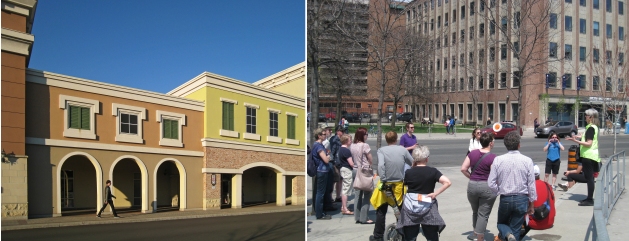The lowly status of North American pedestrians has roots in the 18th century. Dismal walking conditions are enshrined in the dictionary definition of pedestrian: “dull, lacking in vitality and imagination.” Historically, pedestrians were too poor to ride a horse (equestrians). Then, during the 20th century, pedestrians were defined as people who had recently parked their cars.

For more than six decades, the design of our built environment rarely considered the mental health of pedestrians. Buildings were designed to be driven past at the highest speed possible, to be seen from a mile away and/or to be situated close to giant parking lots.
As the mental and physical health benefits of walking become more obvious, the desire will grow for places that are not just walk-able and safe but also walk-worthy. The question of how pedestrians feel is beginning to matter.
In essence, streets must become more than “pedestrian” to better serve pedestrians.
To accelerate the demand for walk-worthy streets and places, we must all become better critics. There can be no change without awareness, and no awareness unless we understand what we are looking at. How healthy is this place? How do I feel when I walk here?
Clearly we need a better visual diet. Only recently has public demand for healthier food changed what people expect from suppliers and restaurants. Higher food quality standards are shaking up the marketplace. Pedestrians have a comparable unmet need to feed their heads with something other than asphalt.
Higher standards for what can be achieved at the same cost can be more widely understood through the following approaches:
- DEMONSTRATE examples that embody higher aspirations
- ANALYZE elements that add up to uplifting, safe, built-to-last design
- COMPARE demand for quality design to concerns for healthier food and green standards
- EXPERIENCE places and the feelings they evoke through facilitated walks and tours
- ENGAGE clients and the public in a dialogue regarding these issues
- QUESTION marketing hype by asking, how does this place really make you feel?
- CONTRAST elements of health-causing and dis-ease causing design
- STATE a higher purpose and legacy for design than to simply contain programs and/or replace infrastructure
DEMONSTRATE examples that embody higher aspirations
ANALYZE elements of uplifting, safe, built-to-last design
EXPERIENCE the feelings that various places evoke. Diagnose your habitat.
Every citizen can learn to be a better critic. In this video, I suggest a simple way to begin sharpening our awareness:
-Sharon VanderKaay




Leave a comment